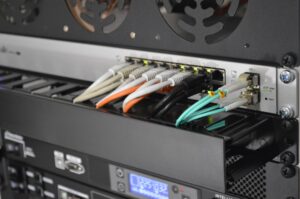Firewalls serve as a critical line of defense in the realm of cybersecurity, acting as a barrier between trusted internal networks and untrusted external networks. Their primary function is to monitor and control incoming and outgoing network traffic based on predetermined security rules.
The significance of firewalls cannot be overstated, especially in an era where cyber threats are increasingly sophisticated and prevalent. The importance of a firewall extends beyond mere protection; it also plays a vital role in compliance with various regulatory standards. Many industries are governed by strict regulations that mandate the implementation of security measures to protect sensitive data.
For instance, organizations in the healthcare sector must comply with the Health Insurance Portability and Accountability Act (HIPAA), which requires robust security protocols to safeguard patient information. A properly configured firewall can help organizations meet these compliance requirements, thereby avoiding potential legal repercussions and financial penalties.
Key Takeaways
- A firewall is a crucial component of network security, acting as a barrier between a trusted internal network and untrusted external networks.
- When choosing a firewall for your network, consider factors such as the size of your network, the level of security required, and the budget available.
- Proper setup and configuration of your firewall is essential to ensure it effectively filters network traffic and protects against unauthorized access.
- Regular monitoring and management of your firewall is necessary to identify and address any potential security issues or breaches.
- Keeping your firewall updated with the latest security patches and configurations is vital for maximum protection against evolving security threats.
Choosing the Right Firewall for Your Network
Selecting the appropriate firewall for your network is a crucial decision that can significantly impact your organization’s security posture. Firewalls come in various forms, including hardware-based, software-based, and cloud-based solutions, each with its own set of advantages and limitations. Hardware firewalls are typically deployed at the network perimeter and provide robust protection against external threats.
They are ideal for larger organizations with extensive network infrastructures. On the other hand, software firewalls are often installed on individual devices and can offer more granular control over application-level traffic. When choosing a firewall, it is essential to consider the specific needs of your organization.
Factors such as network size, the volume of traffic, and the types of applications being used should influence your decision. For example, a small business with limited resources may benefit from a cost-effective software firewall that provides adequate protection without overwhelming complexity. Conversely, a large enterprise may require a more sophisticated hardware firewall capable of handling high traffic loads while offering advanced features like intrusion detection and prevention systems (IDPS).
Setting Up and Configuring Your Firewall

Once you have selected the appropriate firewall for your network, the next step is to set it up and configure it correctly. This process involves defining security policies that dictate how the firewall will handle different types of traffic.
It is crucial to strike a balance between security and usability; overly restrictive rules can hinder legitimate business operations. During the configuration process, it is also essential to enable logging features that allow for monitoring and analysis of network traffic.
Logs can provide valuable insights into potential security incidents and help identify patterns of behavior that may indicate malicious activity. Additionally, configuring alerts for specific events can enable your IT team to respond promptly to potential threats. Regularly reviewing and updating these configurations is vital to ensure that they remain effective against evolving cyber threats.
Monitoring and Managing Your Firewall
| Metrics | Data |
|---|---|
| Firewall Uptime | 99.9% |
| Number of Blocked Connections | 5000 |
| Number of Allowed Connections | 10000 |
| Number of Intrusion Attempts | 100 |
| Firewall Rule Changes | 20 |
Effective monitoring and management of your firewall are essential components of maintaining a secure network environment. Continuous monitoring allows organizations to detect anomalies in network traffic that may indicate a security breach or attempted attack. Many modern firewalls come equipped with advanced monitoring tools that provide real-time visibility into network activity, enabling IT teams to respond swiftly to potential threats.
In addition to real-time monitoring, regular audits of firewall configurations and logs are necessary to ensure compliance with security policies and best practices. These audits can help identify misconfigurations or outdated rules that may expose the network to vulnerabilities. Furthermore, establishing a routine for reviewing firewall performance metrics can provide insights into bandwidth usage and help optimize network resources.
Updating Your Firewall for Maximum Protection
Keeping your firewall updated is paramount for maintaining its effectiveness against emerging threats. Cybercriminals are constantly developing new techniques to bypass security measures, making it essential for organizations to stay ahead of these threats through regular updates. This includes not only updating the firewall software itself but also applying patches and updates to any associated hardware components.
In addition to software updates, organizations should also review and update their firewall rules periodically. As business needs evolve, so too do the risks associated with new applications and services. Regularly revisiting firewall policies ensures that they align with current organizational objectives while providing adequate protection against potential vulnerabilities.
Educating Your Team on Firewall Best Practices

Understanding Common Threats
Employees should be aware of common threats such as phishing attacks and social engineering tactics that could compromise network security. Moreover, fostering a culture of cybersecurity awareness within the organization can significantly enhance overall security posture.
Empowering Employees through Training
Regular training sessions, workshops, and simulations can help employees recognize potential threats and understand their role in maintaining network security.
Encouraging Open Communication
Encouraging open communication about security concerns can also empower team members to report suspicious activities without fear of reprisal.
Integrating Additional Security Measures with Your Firewall
While firewalls are a fundamental component of network security, they should not be relied upon as the sole line of defense. Integrating additional security measures can create a more robust security framework that addresses various attack vectors. For instance, implementing intrusion detection systems (IDS) alongside firewalls can provide an additional layer of protection by identifying and responding to suspicious activities in real time.
Moreover, employing endpoint protection solutions can help secure devices connected to the network from malware and other threats. These solutions can work in tandem with firewalls to ensure that even if an endpoint is compromised, the firewall can still prevent unauthorized access to critical systems. Additionally, utilizing virtual private networks (VPNs) can enhance remote access security by encrypting data transmitted over public networks.
Responding to and Mitigating Security Threats
Despite best efforts in prevention, organizations must be prepared to respond effectively to security incidents when they occur. A well-defined incident response plan is essential for minimizing damage and restoring normal operations swiftly. This plan should outline specific roles and responsibilities for team members during an incident, ensuring a coordinated response.
In addition to having an incident response plan in place, organizations should conduct regular drills to test their preparedness for various scenarios. These exercises can help identify gaps in response strategies and provide valuable insights into areas for improvement. Furthermore, post-incident reviews are crucial for learning from security breaches; analyzing what went wrong can inform future prevention strategies and enhance overall resilience against cyber threats.
By understanding the importance of firewalls, choosing the right solution, configuring it effectively, monitoring its performance, keeping it updated, educating staff, integrating additional security measures, and preparing for incidents, organizations can significantly bolster their cybersecurity defenses against an ever-evolving threat landscape.
Firewalls are essential components of network security, protecting systems from unauthorized access and cyber threats. For more information on the importance of cybersecurity in today’s digital age, check out this article on real-world examples of mathematical modeling. Understanding the intricacies of network security can also shed light on the relationship of sociology with other social sciences, as explored in this insightful article on the role of psychology books in advancing careers in psychology. By delving into these related topics, one can gain a deeper understanding of the interconnected nature of various fields of study and their impact on society as a whole.





















+ There are no comments
Add yours